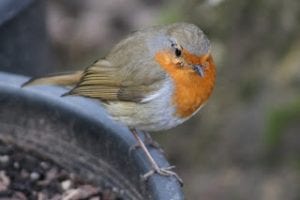By Andy Winfield

I’ve just been turning the compost heap, it’s pretty much the darkest day of the year. I’ve been joined by three bickering robins and a scurrying blackbird. Compost heap turning is a feast for them with all the bugs and worms who themselves are eating the soft plant material in the heap. The Garden is full of wildlife and at this time of year as the bees and butterflies disappear and many birds migrate, we notice the residents that stay around.
Robins are associated with this time of year, their singing snaps through the air; we like to think they’re singing for us, our best friends. Of course, they’re only after us for our debris, the worms in our soil spoil. Robins adapted to a life in woodlands where wild boar rambled around in groups snuffling up the soil; these days gardeners are the boars, helpfully turning over the ground to reveal the treats.
Badgers also co-exist with us in the Garden, they overturn pots and grub up the soil, dig under fences and make little toilets. Despite this we like them, they eat slugs which has to be a big bonus! To live with them we leave out pots full of soil for them to rummage through; when we chop down a grass such as miscanthus we’ll leave the dry foliage outside their set, in the morning we’ll see that its been dragged down inside for cosy bedding. Many gardeners find them an annoyance, but they are part of the landscapes we create and we have to let them live their lives as freely as possible; nature is about balance and these large mammals are and important part of that.
| Grumpy squirrel |
Many grey squirrels live in the trees of the Garden, popping down to tear off fleece or carry food up to their nest. They’re much maligned and are a pest, but I can’t bring myself to hate them; someone once described them to me as elderly red squirrels, crotchety forgetful senior citizens. I once saw one climbing the side of a tree in some urgency with a whole croissant in its mouth; with an angry backward look it obviously didn’t see the funny side.
A crow’s lone caw is evocative of the time of year. One of the cleverest inhabitants of the Garden, they have been known to use tools in some countries; sticks to get out of reach food and car tyres to crack nuts in the road. They’re protective of the Garden and will hassle a passing buzzard or heron that hits the air space; crows are our bouncers.
| Clever crow |
At this time of year we can see the sun come up and down, the latter causing consternation among the blackbird population in the Garden. Isolated warning songs can be heard around dusk; I imagine them charging around shouting ‘don’t panic’ as they panic. They bustle along the ground from shrub to shrub thinking they haven’t been seen, before belting out one of the best songs of the bird world.
The gardening year starts slowly before gathering momentum quickly through spring and into the full helter-skelter of summer when there seems so much life buzzing and scurrying around. On the shortest day nature’s numbers are depleted but there is still much to see. The Garden itself has winter scented flower, bright berries and evergreen gloss. As the light level is at its lowest point on the shortest day, I see that as the end of one gardening year, the day after is the beginning of the next.
From everyone at the Botanic Garden, have a fun a relaxing winter break, you deserve it!
By Andy Winfield

